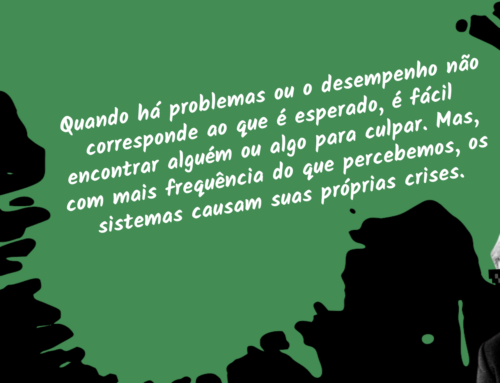“Personal or people development” is a widely used keyword in the corporate world. Companies invest in training, coaching, mentoring, performance evaluations, feedback, and development programs to help their employees improve individual skills, competencies, and behaviors. This is part of the famous “best practices” in organizations that value good old competency-based management.
I myself have designed experiences entirely focused on personal development. But what if the approach is wrong? What if the excessive focus on the individual is limiting the true potential of people?
Well, readers… Far be it for me to say what is right or wrong, the world is already full of moralism. However, if you continue reading, I want to talk about how all this talk of “developing people” not only limits the creative potential of organizations but can also be harmful to individuals.
Development premises
The belief that people should be developed is based on some fundamental premises. These premises have been widely accepted in the corporate world and are often used as the basis for people development programs.
Certainly, there are some assumptions that support this idea. There must be good reasons for organizations to choose this path.
To better understand why so many organizations use this approach, I began investigating hypotheses and assumptions behind these practices, both with my clients and through bibliographical references.
I organized the hypotheses I found in the format “If [condition] is met, then [resulting behavior].”
Here are some of them:
- If human beings are rational and can learn new skills and competencies, then it is possible to train them to improve their performance.
- If individual development is necessary for the organization’s success, then it is the organization’s responsibility to invest in development programs.
- If a lack of individual skills or competencies is limiting the organization’s performance, then it is necessary to invest in training to develop those skills.
- If employees are dissatisfied or unmotivated, then it is necessary to invest in development programs to increase their satisfaction and engagement.
- If the organization wants to remain competitive in a constantly changing market, then it is necessary to invest in development programs to keep employees up to date.
- If we develop employees, then they will behave more in line with our organizational culture.
You might think, “Well, doesn’t this make sense? It seems coherent.”
I too find it coherent, considering that many of the practices that go with these hypotheses were designed in the last century when discussions about power relations, colonialism, and social inequality were not as widespread.
Problematizing development
The problem with these hypotheses is that they ignore the fact that human “development” is a social phenomenon that occurs in a network. They also disregard the fact that individuals develop themselves by their own volition. It is not possible to force someone to develop themselves (and you, who may work with this, surely know that too, right?).
The development of people in organizations is merely a fancy term for a strategy that seeks to maintain social conformity.
Oops, now I’m being harsh.
Hold on. I don’t want to condemn personal development. It would be unfair of me to discard all the work that many people have done to create spaces where individuals can truly develop their skills and competencies.
I certainly don’t want to attack you if you work in this field.
However, I want to provoke critical reflection on how this topic is approached in many organizations. Moreover, I want to draw attention to the limitations of such a strong emphasis on the individual.
Stay with me here, as I’d like to share a few more thoughts on this matter.
The Dark Side of Development

Developing people can give the impression that people don’t know how to take care of themselves and need their parents to do so, or in this case, organizations, to do it for them. This perspective reflects a culture of paternalism and control, placing organizations in a position of power over employees.
I notice that this discourse is often distant from organizations. Many times, development is done under the pretext of “giving more autonomy and maturity” to employees.
In reality, all of this gives the impression that employees are not capable of taking care of themselves and need the company’s intervention and guidance to better themselves.
Developmentalism often concentrates more on individual issues. This results in a limited view of organizational challenges, disregarding broader structural elements, such as power relations, governance, working conditions, and environmental factors.
The practice of developing people is also linked to a certain type of symbolic violence, as it tries to change the so-called mindset of the individual, imposing a way of thinking and acting that is deemed more suitable or valued by the organization. This imposition can be compared to a neocolonialist practice, as it reflects an attitude that places itself as superior and capable of shaping people according to its interests.
I know, I know, I may be coming on too strong. But it’s urgent to talk about these issues! We need organizations that seek decolonial practices instead of trying to colonize their employees with their culture.
The mere existence of an area focussed on developing people in an organization may indicate excessive centralization of decision-making and resource allocation.
In organizations that consider their power structures and seek to decentralize them, responsibility for people’s development is handed over to the employees themselves, who are encouraged to make decisions about their own development.
In addition to everything I’ve brought up here, there are other points that deserve attention:
- The idea that individual skills and competencies are the main factors responsible for a person’s success or failure in their career, disregarding factors such as social privileges, opportunities, and structural conditions;
- The belief that individual development is the solution to complex organizational problems, ignoring the need for structural and systemic changes;
- The pressure for employees to be constantly developing and improving their skills, creating a culture of competition and individualism at the expense of collaboration;
- The lack of attention to the emotional and psychological well-being needs of employees, focusing only on technical skills and professional competencies;
- The imposition of a single model of success and development, which may not be suitable or valued by all employees and may reinforce stereotypes and prejudices;
- Trainings that often disregard people’s work overload and propose a series of activities for those who already have a lot on their plate.
Often these ideas of more maturity and autonomy are implicit in the discourse on people development.
It can be difficult to reveal what is hidden in a discourse that claims to be concerned with taking care of people.
As you can see, this development business comes with pretty gruesome tensions. Exposing it in this way might make it seem like it’s the end of the world and the best thing to do is get rid of it… But it’s not quite like that.
I don’t want to just invite you for critical reflection and stop here. There are paths that value the emancipation of relationships in the work environment and take care of this development theme.
So, what to do then?

People can be compared to the work of a gardener, who creates conditions for plants to grow and bloom on their own, rather than a sculptor, who shapes and sculpts material according to his own vision. This metaphor underscores the importance of creating favorable conditions for people’s autonomous growth and development, rather than trying to mold them to fit the organization’s needs.
The first thing is to stop thinking that people need to be developed. The organization can and should create conditions for employees to grow and strengthen in all ways. However, making it mandatory is not a good approach.
Nobody develops anyone. People develop in communion.
A paraphrase taken from Paulo Freire
Of course, if someone works in a metallurgical industry, they will have to do a series of technical training to be in the work environment. I’m not suggesting here that there aren’t compulsory types of training organizations.
My point is that resources should exist for employees to use if they want to. In other words, free up the money for the crew to develop themselves as they see fit. Respecting, of course, the restrictions of each context.
This is the point concerning the issue of development itself.
Work the system
Now stick with me here. All these developmental approaches want to stimulate certain behaviors in individuals. Right?
To change people’s behavior, you need to alter the structures around the individual so that they behave differently.
In this way, instead of dictating the individual’s way of thinking, you change the interactions between the elements of the environment, allowing the person to choose their own way to adapt.
Investing in education is important, but we hardly have time to wait for people to become aware and change their behaviors.
It is important to note that one thing does not negate the other. For example, we need to invest in actions to raise people’s awareness of the impact of pesticides, gender inequality, social disparities and everything else.
But if there are no public policies (structures) that propose interventions in these issues, society collapses.
That’s why the title of this post is “Develop Systems, Not People”. It’s time to design organizations that treat people as adults capable of making choices, making decisions, and following their own paths. The aids and nudges are still useful and necessary, but proposed in a different way.
It is pointless to water the plant (the individual) if the soil (the system) is not well taken care of. :)
Often, people in organizations believe that training and development programs are the solution to a number of internal problems.

Working on organizational systems is like building a house. If we focus only on improving each brick (individual development), without taking into account the design and overall structure of the house (organizational system), the house can be unstable and inefficient, no matter how beautiful the brick is.
A common example of a problem that many organizations try to solve with training is the lack of diversity and inclusion. It is common for companies to create training programs to teach employees to be more inclusive and to handle differences. Let’s be real, right? We know that most of the time this is not enough to create a culture of inclusion.
For an organization to be inclusive, it is necessary to work on the system as a whole. This includes reviewing policies like recruitment and selection policies, wages, investigating possible unconscious biases and assumptions of the organization, and then investing in educational programs that address the structural inequalities that affect diversity and inclusion.
Another example is the lack of employee engagement. Many organizations believe that leadership training and the promotion of a feedback culture are the solution to this problem. However, often the lack of employee engagement is caused by structural problems such as lack of recognition, low wages, overwork, and lack of autonomy.
A different perspective
I want to invite you to help organizations balance their focus on both structural interventions and people development.
We can’t be one sided; both are relevant.
I hope that this handful of words has piqued your curiosity to learn more about how to work systems and explore other paths that allow self-development in your organization.
If you identified with these ideas and want clear next steps on how to move forward with this topic, you can:
- Invest in structures and policies that allow employees to make decisions and choices autonomously.
- Provide development opportunities that are aligned with the personal values and interests of employees, not just the needs of the organization.
- Recognize that the development of individual skills and competencies is not enough to solve complex organizational problems, and that structural and systemic changes are also necessary.
- Offer resources and information so that employees can make decisions about their own development, without it being imposed by the organization.
- If you are going to do training, look for approaches that prioritize self-direction and collective learning rather than lecture-style classes.
One more thing, we at Target Teal can help you with these and many other organizational challenges. To learn more about systemic change, you can join our course on Applied Systemic Thinking and Complexity, and Culture Hacking.
We can assist you in designing interventions for the structural issues that need to change for your organization to become more humane and responsive to the challenges of the 21st century.
Give us a call and let’s have a coffee, and we can discuss consultancy!
Thanks for sticking with me to the end! :)
This post had feedback, suggestions, and revisions from the following people:
Tami Lima, Gabriela Inácio, Raquel Ferreira, Maria Thereza, Aline Figueiredo, Samir Bravo, Erika Rios, Mônica Santos, Cynthia Mendes, Eliza Fortuna, Felipe Novaes, Rodrigo Bastos, and Davi Zimmer.
I’m very grateful for each of these people’s help in conceiving this article. <3






Leave A Comment